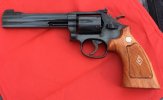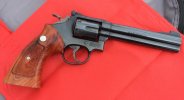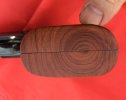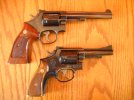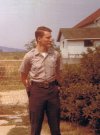In another thread, Thumbcocker shared the good news of his acquisition of a K-38. I decided that model needs a little airtime.
Sometimes all the planets align. There’s nothing outwardly extraordinary about a K-38. At its core, it is a K-frame Smith & Wesson chambered in 38 Special, but it is an extraordinary collection of features.
To the uninformed, it looks like a 6” barreled K-frame and nothing to get excited about. To the knowledgeable, it is perhaps the best, mass produced, affordable 38 Special target revolver ever made. It certainly wasn’t the only type, nor was it rare, or even the pinnacle of centerfire target DA revolvers but it was always a lot of gun for the money.
I know a lot of the features pre-date the introduction of the Target Masterpiece but to keep this manageable, I’m only going to address post war models.
Like most industry that existed in the U.S.A. at the time, Smith & Wesson took a detour in the early 1940’s. When that little event called World War 2 was over……. Smith & Wesson returned to a more normal business model. In 1946 S&W introduced a model called the K-38 Target Masterpiece. While it was basically a K-frame revolver, it incorporated just about every feature a target shooter (particularly a Bullseye competitor) desired.
The barrel length was typically 6” or occasionally 8 3/8”. The 8 3/8"” barrel allowed for the maximum sight radius under the regulations for most matches. There were K-38 Target Masterpiece revolvers made with 4” or 5” barrels but they are rare. The sights were VERY good for the money. You got a square, vertical front blade matched to Smith & Wesson’s excellent adjustable rear sight. The S&W adjustable rear sight is so ubiquitous today that it is easy to take that engineering for granted. There’s a lot going on with that rear sight and S&W accomplished that precision very efficiently. It is such a good design that S&W adjustable rear sights are often fitted to non-Smith & Wesson guns. The S&W adjustable rear sight form can be improved but not for the same low cost. In between the front and rear sights on K-38 is a serrated, raised rib. The front strap and backstrap of the grip frame were also serrated.
The guns were all square butt frames up to 1995. There were combinations of target hammers, target triggers and target grips (sometimes referred to as 3 T’s when all are present) but not every K-38 left the factory with all three. Despite what some collectors will claim – the gun was still known as a Target Masterpiece regardless of those trigger/hammer/grip details. The larger target grips came in different styles and were offered as optional factory grips to the Magna style starting in 1951. Many K-38’s will wear Target grips that were not original to the gun but only the most detailed oriented collector will care if the grips are not original to the gun. All the early examples I’ve seen had frames cut for a trigger stop but this part is not always present. Sometimes the trigger stop was simply not installed at the factory and often it was removed from guns after delivery. If the trigger stop is present and comes loose, it can tie up the action. To prevent such a failure, the stops were simply removed. Target shooters have mixed feelings about trigger stops but the stops were almost universally removed from any duty gun.
The DA/SA action is pure S&W K-frame but that action needs no improvement. A old K-frame that has been used but not abused will have a DA and SA action that is incredibly good.
On the topic of the name – Prior to 1957, Smith & Wesson DA revolvers were known by model names outside the factory. In 1957 S&W adopted model numbers for the identification of models. This change was not universally embraced and to this very day, I encounter people that still use the Smith & Wesson model names to describe S&W models regardless of the date of manufacture. Even Smith & Wesson continued to market their revolvers with a combination of model numbers and old model names for many years. The models went through all the same engineering changes as the rest of S&W’s revolvers and dash numbers were used to designate those changes.
Regardless of the designation, the K-38 Target Masterpiece / Model 14 was produced in large quantities and proved to be more than the sum of its parts. The guns were affordable, obtainable, durable (when not abused) and capable of remarkable accuracy.
I’ve previously commented that the model 15 “Combat Masterpiece” could be had essentially configured as a 4” model 14 with a ramp front sight. This made the Model 15 a duty gun that was as close to a fine target gun as one could get and still be a practical duty gun. This was perhaps the highest praise for the engineering that went into the Target Masterpiece.
Long live the “everyman’s target revolver”!
